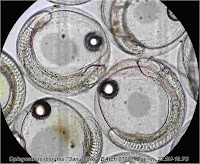Priminary study on embrionic development of Pacific beakfish Oplegnathus insignis in North of Chile

I published my study of Oplegnathus insignis about embryonic development in 2007. Full text at my archive.
Abstract
Since 2006, the project "Optimizacion de la tecnologia de produccion de jevenile de San pedro (Oplegnathus insignis) " is running under INNOVA CORFO with CORDUNAP.
Wild captured O. insignis are rearing at Universidad Arturo Prat Ciencia Del Mar (UNAPDCM) since 2002. Ten females (biomass 13.07 Kg) spawned 1,768,292 eggs with 20 times spawning from January 7 to March 17, 2007.
The egg showed chorion diameter was 0.87 to 0.96 mm at anterior-posterior axis (AP), dorsal-ventral body axis (DV) and left-right body axis (LR). Oil droplet diameter was 0.16 to 0.21 mm (AP) and 0.18 to 0.20 mm (DV). Blastodisk diameter was 0.12 to 0.17 mm (AP) by 0.57 to 0.70 mm (LR) and blastodisk occupied 20 % of embryo length at morula stage. Blastoderm diameter was 0.18 (DV) by 0.67 mm (LR) at blastula period. Germ ring showed 0.26 mm (DV) by 0.75 mm (LR) and 0.05 mm thickness. At embryonic shield stage, embryo was 1.14 mm (AP), 0.04 mm (DV) and 0.15 mm (LR). Embryo diameter was 0.88 mm (AP) and blastodisk occupied 98 % of embryo length. Embryo length (AP), thickness (DV) and width (LR) were 1.45 mm, 0.16 mm and 0.21 mm at 1 to 5 somite, 1.57 mm, 0.15 mm and 0.21 mm in more than 21 somite accordingly at segmentation period. Pre-hatch embryo showed 1.65 mm (AP). It took 28 hours from fertilization to hatch-out under water temperature 20 C approximately.
Wild captured O. insignis are rearing at Universidad Arturo Prat Ciencia Del Mar (UNAPDCM) since 2002. Ten females (biomass 13.07 Kg) spawned 1,768,292 eggs with 20 times spawning from January 7 to March 17, 2007.
The egg showed chorion diameter was 0.87 to 0.96 mm at anterior-posterior axis (AP), dorsal-ventral body axis (DV) and left-right body axis (LR). Oil droplet diameter was 0.16 to 0.21 mm (AP) and 0.18 to 0.20 mm (DV). Blastodisk diameter was 0.12 to 0.17 mm (AP) by 0.57 to 0.70 mm (LR) and blastodisk occupied 20 % of embryo length at morula stage. Blastoderm diameter was 0.18 (DV) by 0.67 mm (LR) at blastula period. Germ ring showed 0.26 mm (DV) by 0.75 mm (LR) and 0.05 mm thickness. At embryonic shield stage, embryo was 1.14 mm (AP), 0.04 mm (DV) and 0.15 mm (LR). Embryo diameter was 0.88 mm (AP) and blastodisk occupied 98 % of embryo length. Embryo length (AP), thickness (DV) and width (LR) were 1.45 mm, 0.16 mm and 0.21 mm at 1 to 5 somite, 1.57 mm, 0.15 mm and 0.21 mm in more than 21 somite accordingly at segmentation period. Pre-hatch embryo showed 1.65 mm (AP). It took 28 hours from fertilization to hatch-out under water temperature 20 C approximately.




Comments
Post a Comment